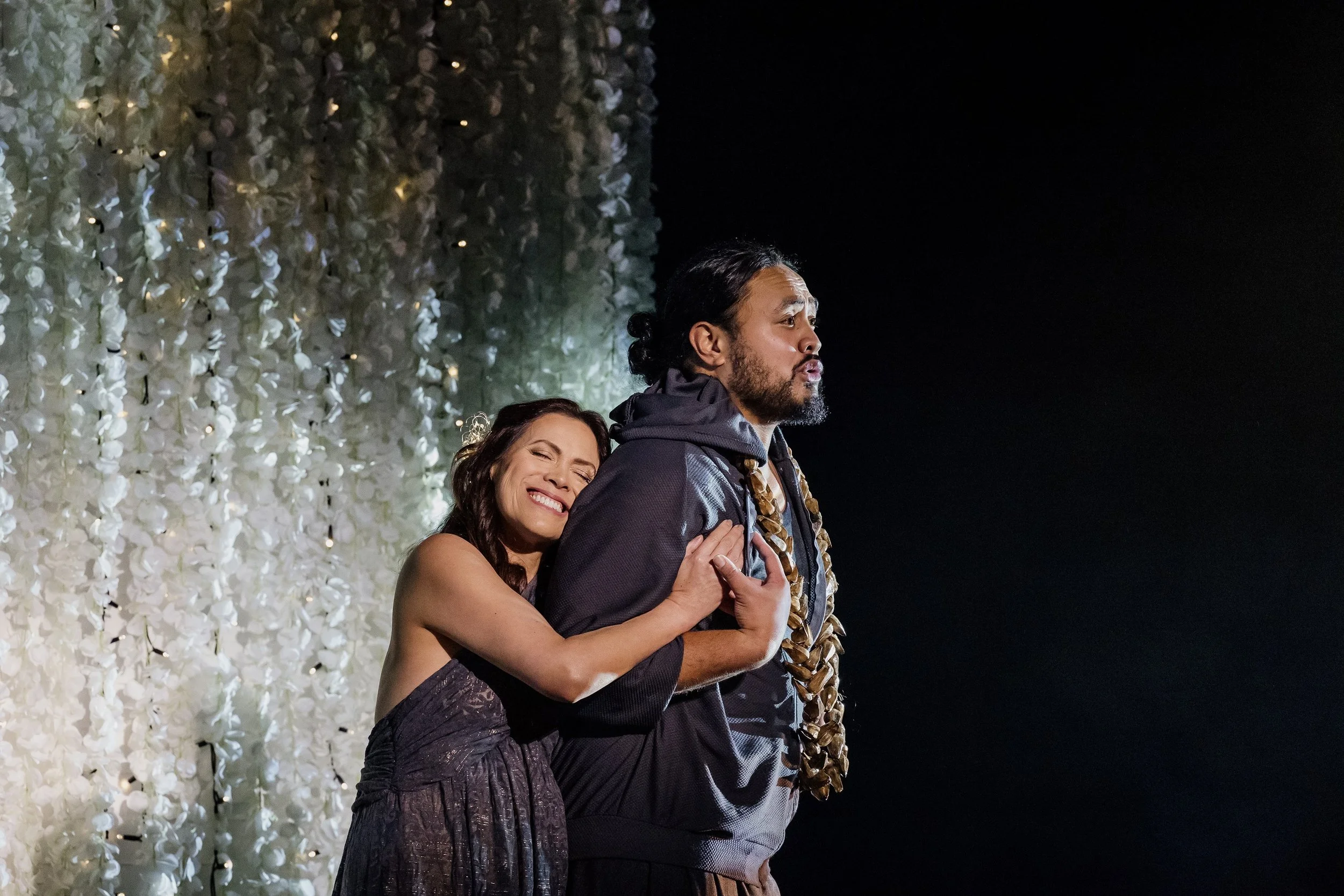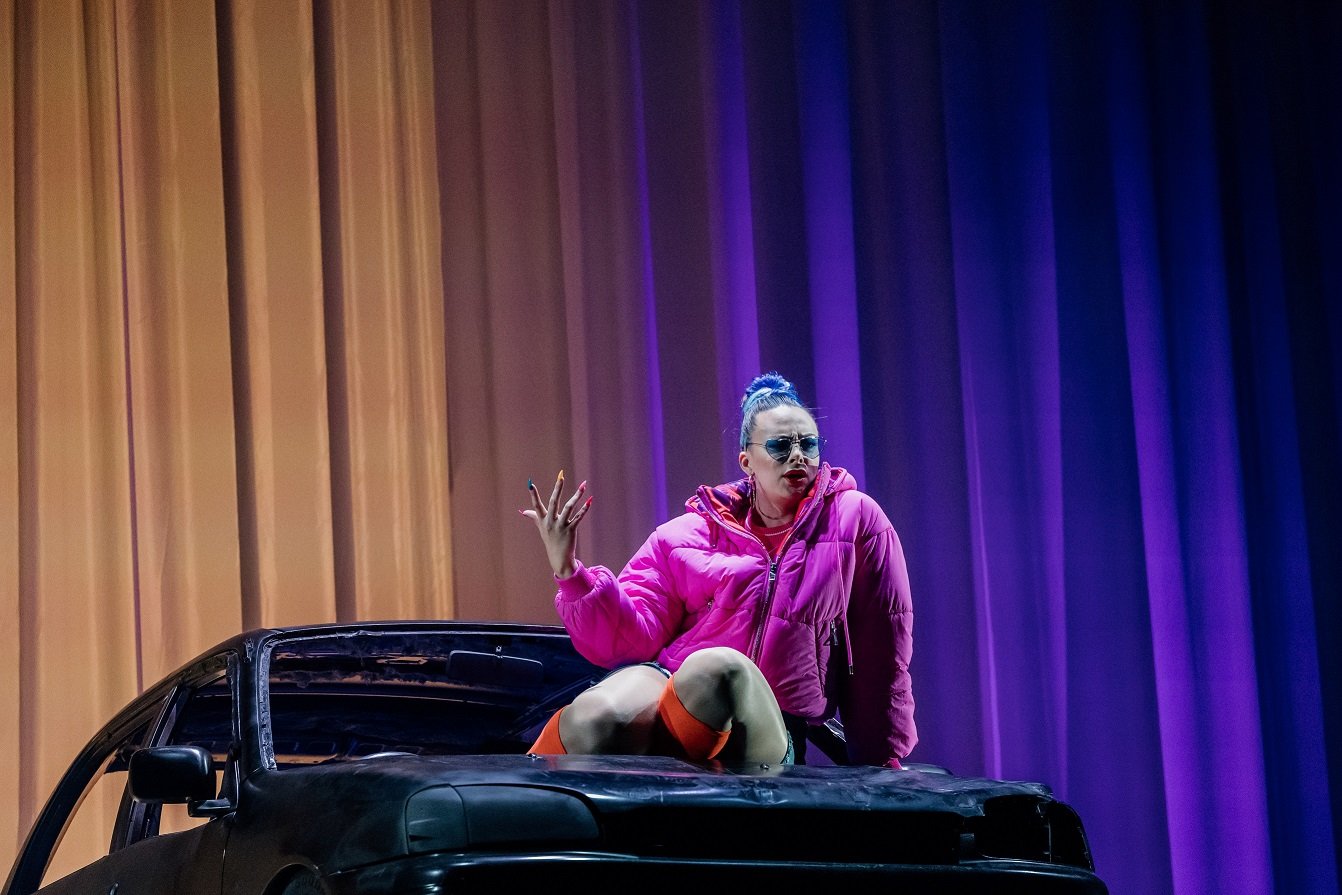(m)Orpheus: death and dreams in a stunning dance-opera
Soprano Deborah Wai Kapohe (Eurydice) and Samson Setu (Orpheus) - fine and passionate singing
Image credit: Andi Crown
In an artistic world where a desire for innovation through a contemporary lens is becoming commonplace, director and choreographer Neil Ieremia's (m)Orpheus is the most imaginative "reimagining" I have experienced. And I use the word "experienced" advisedly, because this stunning fusion of Baroque opera, Siva Samoa (Samoan dance), contemporary dance and timeless storytelling is rich, multi-sensory and full of complex and fearless boundary-crossing.
In his introductory note, Ieremia expresses gratitude to his creative team, which includes composer Gareth Farr, conductor Marc Taddei and designer Tracy Grant Lord, for "running headlong with me into the unknown and designing a world where dreams can conquer death."
It is indeed a brave and risk-taking creation. Gluck, composer of the dance-opera, was keen to reform opera himself, composing Orfeo ed Euridice in Italian, reworking it later as a French opera and always striving for "noble simplicity" in plot and music. This opera was the most popular of his oeuvre, composed in the tradition of azione teatrale, that is, an opera on a mythological theme which includes both choruses and dancing.
Black Grace dancers Rodney Tyrell and Fuaao Tutulu Faith Schuster represent the lovers
Photo credit: Andi Crown
(m)Orpheus is based on the well-known story of Orpheus and Eurydice, where the hero, grief-stricken by his wife’s death, accepts the challenge offered by Amor, god of love, to descend to the Underworld and bring her back to life. Orpheus’s failure to observe the condition that he must not look at her during the journey back to the real-world surface is, of course, his undoing and the ultimate tragedy of the story.
It all begins with a sprightly overture from the small forces in the pit, underlaid by the distinctive timbre of marimba. This is played against a sombre black set, two entwined and wraith-like dancers crossing the stage and disappearing. Soon, the black net curtain rises and the set becomes silvery. We are in a suburban home, white-clad mourners dancing and singing (in Samoan) the grief-laden opening chorus, lamenting the death of Eurydice. Orpheus (baritone Samson Setu), touchingly sings forth just the name of his lost beloved from the upper-level of the brilliantly inventive set – yes, it’s a carport and that large sculptural shape is a full-size car body.
The triumph of the production is the opulent overlay of both a contemporary story and Pasifika culture on the famous classical myth. From the outset, all the layers are there - Gluck’s Baroque rhythms played with Farr’s timbral surprises under the stylish baton of Taddei, graceful Samoan dance gestures and fine singing from the story-telling chorus, the unexpected overlap of singing and dancing and an imaginative and beautiful set and lighting design conjuring both a contemporary funeral and a sense of otherworldly magic.
Soprano Madison Nonoa as Amor, god of love
Image credit: Andi Crown
Amor (soprano Madison Nonoa) arrives in a colour-burst to give hope to the bereaved Orpheus. A male god in the original Gluck version, albeit sung by soprano, here Amor is given a comedic reading, and costumed accordingly – hot-pink shiny puffa jacket, a denim mini-skirt, bright orange long sox and sneakers and sunnies. Her arch, flirtatious persona and colourful modern dress are in marked contrast to the rest of the cast and her singing is accomplished and extrovert.
It's a story that moves from despair to hope and back again. Setu’s heart-rending aria, “I have lost my Eurydice” was sung with genuine pathos, with beautifully simple accompaniment by violin and guitar. His voice is strong and lovely, and more stylistic shaping of vocal phrases would have added to the expressive impact.
Soprano Deborah Wai Kapohe is a touching Eurydice, singing with beauty of tone. She is a calm smiling presence in the centre of the famous Dance of the Blessed Spirits in the Elysium. That dance, of which only the “A” section was performed, (consistent with the 1762 Vienna version of the opera on which this production was based), was scored here for strings, clarinet and flugelhorn and marimba, and the famous flute melody was mostly played by violinist Amalia Hall.
The emotional heart of the story is in Act 3 when Orpheus tries to lead Eurydice out of the Underworld to the surface. Hurt by his apparently cold demeanour, she resists, and he eventually weakens, only to lose her again. This act offered the finest and most passionate singing from both Wai Kapohe and Setu, and their exchanges as he struggles to meet Amor’s conditions make for a moving and dramatic duet.
Deborah Wai Kapohe (left) and Samson Setu (centre) with the dancing singers of the chorus
“…storytelling through Siva Samoa”.
Image credit: Andi Crown
Ultimately the greatest power of the production’s storytelling is in the dancing. At several moments during the story the dancing couple, representing the lovers, take the stage to express the narrative in movement. The ensemble dances are a major feature, using traditional dance forms like sāsā (sitting dance) and fa’ataupati (slap dance) and integrating these with contemporary dance in Ieremia’s inspired choreography to Gluck’s music. The large ensemble dance in Act 3 was a magnificent and joyous conclusion, involving the whole chorus alongside the Black Grace dancers, expressing the happy reunion of the lovers, and bringing many in the audience to their feet for an ovation.
But it was not the end. Eurydice is lost to death for a third time, and the “B” section of the Dance of the Blessed Spirits makes a surprise appearance, introducing a new timbre which suggests Orpheus has awoken abruptly to the reality of his world. The quiet and tragic ending, less exuberant than the joyful dance that preceded it, nonetheless confirms the dream-like quality of the story.
(m)Orpheus based on an opera by Christoph Gluck, presented by NZ Opera and Black Grace Dance Company, Neil Ieremia (director and choreographer), re-orchestration by Gareth Farr, Marc Taddei (conductor), Tracy Grant Lord (designer), JAX Messenger (lighting designer), Jacqueline Coats (assistant director)and musicians from Orchestra Wellington. Wellington season, September 20-23, 2023. Tickets available here.
You can read my preview of the production, with interviews with Marc Taddei and Gareth Farr, here.




